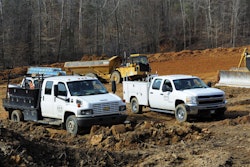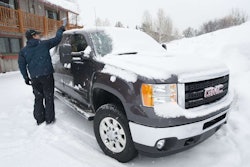 Selecting and using the correct style strap for recovery or retrieval will prevent unnecessary jobsite safety risks
Selecting and using the correct style strap for recovery or retrieval will prevent unnecessary jobsite safety risks
By Tim Walton
When I’m working on houses out in rural areas, the width and condition of the roads aren’t always ideal, especially with multiple contractors trying to figure out how to access the jobsite. Sometimes just getting around each other can be a challenge.
Since my work truck isn’t equipped with a winch, two of the best tools I have on board are a tow strap and a recovery strap.
I’ve gotten my own pickup stuck where I misjudged the condition of an unfinished driveway, which, as it turns out, was water logged. Fortunately I had my recovery strap and the general contractor gave me a hand and I was back on my way.
Tow straps and recovery (often referred to as “snatch”) straps may look similar. But they are designed for entirely different uses – and substituting one for the other is a serious safety issue.
Understanding the material and design difference between the two will make them more effective in your arsenal of self-recovery tools – and prevent you from the potential safety risks of using them incorrectly.
Tow Straps
Tow straps are designed to help you move another vehicle that is disabled but not necessarily stuck. However, they are not designed to be used as a snatch strap.
That’s because tow straps are constructed and designed not to stretch under load, so the force on one end is evenly distributed to the load on the other end with the length of the strap staying relatively constant.
In other words, there’s not the constant stretching and retracting between vehicles like would happen if you used a snatch strap for the same purpose.
Cargo straps, lifting straps and tree-trunk protectors have similar characteristics to tow straps.
Recovery Straps
When you have a vehicle truly stuck, however, you need to have some “give” in a strap to absorb the applied forces during the recovery process – and to provide additional kinetic energy to maximize the pulling power.
Recovery straps (and ropes) are designed to have a rubber band-like stretch to them, which not only multiplies the force by storing the kinetic energy in the strap or rope itself, but also allows you to keep momentum making the traction of the tow vehicle less of an issue.
That stretching of a recovery strap greatly reduce the ragged jar when the slack is gone, which protects the attachment points on both vehicles from damage.
Strap Ratings
With either type of strap, make sure they’re rated for the applied loads. (Load ratings apply not only to straps, but to any component being used in the pull including anchor straps, shackles and hooks.)
It’s always prudent to use a strap rated for 3 to 4 times the gross vehicle weight (GVW) of your pickup. That way should you ever have need to be snatched from a stuck or towed a short distance when your pickup is heavily loaded, there’s a big safety margin.
Pulling a stuck pickup puts tens of thousands of pounds of force into a strap, and using an unrated strap, or one not rated for that load, is dangerous. The biggest issue is the strap could cause serious injury when it parts ways because of it being over-stressed.
Pay attention to strap width (and rope diameter), too, when determining the breaking strength of the rope or strap as designated by the manufacturer.
Nothing makes one feel stupid faster than pulling out a three-inch wide snatch strap only to find two-inch-wide shackles are all that you have to make the hook-up.
I know from personal experience it’s tough to make those heavy webbing eyes fit into that smaller space.
Good Hook-ups
Inspect the straps for damage each time you use them. Check for cuts, frays or damaged stitching, which could have occurred during use or even while in storage.
Also check all the shackles or other gear you might be using to be sure they are 1) in good condition, and 2) properly connected.
Check the equipment again after use to ensure it’s still in good condition before storing.
Ensure that vehicle attachment points are structurally sound. Identify attachment points for towing and avoid loops intended only for securing the vehicle during transport.
If you’re going to use the receiver hitch on your pickup, you’re better off using a D-Ring hitch adapter – instead of trying to rig something with the pin or something else where you don’t know the load rating.
Also, never attach a recovery strap or rope with a knot. Doing so weakens the connection. Loop it around and back through the eye or, better yet, slip the eye over the clevis of an appropriately rated shackle.
Speaking of making the right connections, here’s a list of straps and ropes that will make those self-recovery and towing tasks a lot easier and safer.
 Bubba Rope
Bubba Rope
Bubba Ropes were developed for military use to safely pull off-road vehicles out of mud, sand or snow. Their kinetic energy recovery rope has the ability to stretch up to 30 percent and that rubber-band-like effect is great for getting a stuck vehicle moving. Their recovery rope is coated with Gator-ize, a formulated polymer coating that makes them water, UV and abrasive resistant. The 7/8-inch x 30-foot has a minimum breaking strength of 28,600 pounds, is built in the USA, and comes with its own mesh duffle bag.
Bubba Rope; bubbarope.com; 877-499-8494
 Master Pull
Master Pull
The Super Yanker from Master Pull is made in the USA out of double-braid nylon rope able to stretch 30 percent when used properly. When stretched, the two braids are pulled tighter allowing the rope to absorb energy and lengthen without stretching the nylon fibers themselves. This allows the rope to be used for years without damaging the rope. The stretch also provides shock absorption helping to reduce stress on vehicle components and passengers by removing the abrupt jerking action from using other types of straps or chains.
Master Pull; masterpull.com;
360-714-1313
 WARN
WARN
Recovery Straps from WARN are constructed from high quality nylon web encasing a red warning marker to indicate damaged webbing. The end loops are reinforced with abrasion resistant wear pads. Some of Warn’s recover straps include a nylon sliding sleeve to help prevent excessive wear caused by exposure to sharp objects often found in the heavy construction world. Warn also sells a variety of proper tree trunk protectors and choker chains for self-recovery operations.
WARN; warn.com; 800-910-1122
 Rugged Ridge
Rugged Ridge
Rugged Ridge premium recovery straps are available in a variety of sizes. The straps are heavy-duty, constructed with durable mildew-proof nylon with abrasion resistant reinforced eyes. The nylon absorbs the shock of heavy pulls better than polyester, and its elastic properties help aid in a quicker recovery. Their recovery straps are available in 2-inch x 30 feet (20,000 lbs.); 3-inch x 30 feet (30,000 lbs.); and 4-inch x 30 feet (40,000 pounds capacity).
Rugged Ridge;
770-614-6101
 TeraFlex
TeraFlex
The TeraFlex 30-foot Tow Strap features a 20,000-pound rating with red stress thread for a visible warning of overstress and potential strap failure. It features double-reinforced stitched-loop eyes and measures 30 feet long x 2 inches wide. TeraFlex Tree Strap (3-inch x 7 feet) provides a winch anchor for various recoveries and prevents cutting into the bark of trees. It’s made with double-reinforced stitched loop ends and a 20,000-pound rating.
TeraFlex; teraflex.biz;
801-288-2585
 ARB USA
ARB USA
The ARB snatch strap is a very effective method of extracting an immobilized or bogged vehicle when a second vehicle is present. The elasticity in a snatch strap is what makes it work; the kinetic energy generated by the elasticity aids with the recovery itself, while at the same time reducing the chance of vehicle damage. The 17,500-pound-capacity straps are recommended for most 4WD vehicles, with 24,000-and 33,000-pound-capacity versions better suited to heavy duty applications.
ARB; arbusa.com; 425-264-1391
 US Cargo Control
US Cargo Control
US Cargo Control’s recovery/tow straps can be used for both recovery and towing. They’re made of nylon wedding, which is durable and strong, yet has the capacity to stretch 7 to 10 percent at rated capacity. The straps feature loops reinforced with Cordura on the inside – an extremely durable fabric that resists wear and tear. This is designed to prolong the life of the strap by adding protection at its main wear points. Some of US Cargo Control’s straps utilize a two-ply design that doubles the strength of the strap while maintaining a narrow width.
US Cargo Control; uscargocontrol.com; 319-213-9775








